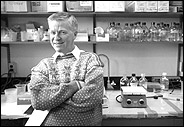Battling bacteria
Thirty years ago, medical scientists were trumpeting the imminent conquest of bacterial infections by antibiotics. Today, chastened researchers are racing to develop new tools to battle antibiotic-resistant bacteria. Dr James Coulton, a professor in the Department of Microbiology and Immunology, is among those waging this battle.
 Professor James Coulton
Professor James Coulton |
|
Coulton is collaborating with colleagues in Canada, the United States and Germany to develop a microscopic Trojan horse: a way of tricking an antibiotic-resistant bacterial cell into allowing an antibiotic agent through its outer membrane walls so it can inflict a fatal blow. Along the way, the researchers must determine the shapes of protein receptors in the membrane, and design chemical agents that can hitch a ride inside the horse.
Coulton, a molecular microbiologist, explains that his research team studies what happens at the interface between bacteria and their environments. "We are interested in how bacteria grow rapidly, divide, cause disease, and take nutrients up from their environment. Then we want to see what scientists can do to limit that growth and curb infection."
In this project, they are studying E. coli (a common pathogen that causes gastrointestinal problems but provides an excellent model for bacterial studies) and a protein on its surface known as FhuA (pronounced foo-ay) that acts as a molecular machine. FhuA is a transporter of iron across the cell membrane.
Iron is essential for the growth and survival of all cells. When only a small supply of iron is available -- as is the case for bacterial cells inhabiting the human body -- FhuA's role is to recognize certain iron-containing compounds and act as a receptor for them. Coulton and his colleagues, the first researchers to discover how this happens, published their results as a six-page article in Science in 1998.
After purifying the protein in the lab, they grew it in a crystal shape, like a sugar cube. Then they took a three-dimensional snapshot of it, using a sophisticated technique known as x-ray crystallography.
Coulton says that because McGill currently lacks expertise in x-ray crystallography, he has been working with Wolfram Welte, an expert in Konstanz, Germany, to carry out this aspect of the research.
|
Use antibiotics carefully Bacterial resistance to antibiotics is a growing problem, fueled by the overuse and misuse of these drugs. As the winter bug season approaches, Professor James Coulton has some reminders on the proper use of antibiotics: Only take an antibiotic when a bacterial infection has been diagnosed. It will be useless against a virus anyway.
|
|
"McGill is rather bereft of structural biologists, but I hope this situation will change, given the enormous power of this kind of science." While the University hired some promising young structural biologists a few years ago, Coulton would still like to see McGill expand further into this field. "We are currently limping along without the structural biology that has become quite prominent at other major North American and European universities."
The results he and Welte achieved with x-ray crystallography were certainly exciting. "The snapshots showed a molecular machine with no iron and with iron -- and there is quite a dramatic difference between the two structures," Coulton says. They discovered that the receptor changes shape when it binds with the iron compound, a signal to begin the next step of bringing the iron into the cell.
Then they had to design a molecule that looks like an iron compound, but that actually has an active antibiotic fragment attached. Like the Trojan horse, "it looks good to E. coli because it has iron, but it is ultimately fatal to the bacteria," he explains, adding, "We can only do this if we know the size, shape and organization of the FhuA molecular machine."
In what Coulton believes is the first time an antibiotic has been bound to an iron compound transporter, he and Welte succeeded with albomycin, an antibiotic that is effective against a variety of bacteria, including E. coli and salmonella. They recently did the same thing with rifampin, another, very different, antibiotic. Coulton plans to try this approach with a number of different antibiotic agents.
Recently, Coulton and several other researchers with complementary fields of expertise formed a new team to pursue studies on novel antibiotics using the Trojan horse principle. They include Les Tari, at the University of Calgary, who has been studying another protein that is part of this transportation mechanism within bacterial cells, and Franois Malouin, at the Universit de Sherbrooke, who is familiar with screening techniques used to identify novel compounds that can block the growth of bacterial cells. The fourth member of the team is Marvin J. Miller, a professor of chemistry and biochemistry at the University of Notre Dame.

